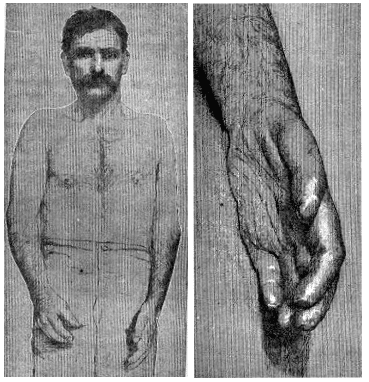Klumpke Palsy
Description
Lower brachial plexus injury, with consequent weakness and wasting of the C8–T1 musculature. The syndrome usually follows birth injury (traction of the after-coming arm with breech delivery), arrest of a fall by grabbing on to a projection, or motor vehicle accidents.
Clinically, brachial plexus injuries can be divided according to their location into injuries of the upper plexus (Erb–Duchenne palsy) and of the lower plexus (Klumpke palsy)
When associated with violent abduction/stretch injury, the sympathetic fibres may also be damaged, with consequent Horner syndrome.
History
1885 – Augusta Klumpke (1859-1927) examined cases of varying degrees of brachial plexus paralysis and conducted her own experiments in Vulpian’s laboratory at the Hôtel-Dieu. Her published work on the “Contribution à l’étude des paralysies radiculaires du plexus brachial” was awarded the 1886 Gôdard Prize by the French Academy of Medicine.
Contrary to popular opinion, Klumpke’s careful review of multiple cases, revealed that lesions involving a proximal injury to the nerve roots of the lower plexus (radicular paralyses), were accompanied by oculopupillary phenomena (Horner syndrome)
…une symptôme pathognomonique pour ainsi dire des paralysies radiculaires inférieures, symptômes que Ton ne retrouve pas dans les paralysies totales évoluant vers le type Duchenne-Erb: ce sont des phénomènes oculo-pupillaires…Or pour nous, les paralysies radiculaires seules s’accompagnent de phénomènes oculo-pupillaires.
Ces phénomènes, qui sont constants dans toute paralysie véritablement radiculaire inférieure, sont caractérisés par du myosis, par le rétrécissement de la fente palpébrale, et dans quelques cas par la petitesse et la rétraction du globe oculaire. Dans 3 observations on a, de plus, noté {‘aplatissement de la joue du côté correspondant à la paralysie.
Klumpke 1885: 597-598
Oculopupillary phenomena are a pathognomonic symptom of lower radicular palsy, that one does not find in total paralysis of the brachial plexus such as the Duchenne-Erb type. In our opinion, only radicular paralyses are accompanied by oculopupillary phenomena.
These phenomena, which are constant in all true lower radicular paralyses, are characterized by myosis, by a stricture of the palpebral fissure, and, in some cases, by the smallness and the retraction of the eyeball. In three observations, we have, in addition, noted a flattening of the cheek on the side affected by the paralysis.
Klumpke 1885: 597-598

Klumpke was able to prove experimentally that the lesion causing the oculopupillary phenomena was at the rami communicantes rather than a lesion in the cervical portion of the sympathetic system. Klumpke severed the brachial plexus at various levels in dogs. She was able to recreate the oculopupillary phenomenon by cutting the C8 and/or T1 nerve root at the level of the intervertebral foramina.
Associated Persons
- Augusta Déjerine-Klumpke (1859-1927)
Alternative names
- Klumpke paralysis
- Klumpke’s palsy
References
Historical references
- Klumpke A. Contribution à l’étude des paralysies radiculaires du plexus brachial. Paralysies radiculaires totales. Paralysies radiculaires inférieures. De la participation des filéts sympathiques oculo-pupillaires dans ces paralysies. Revue de médecine (Paris). 1885; 5: 591-616; 739-790
Eponymous term review
- Merryman J, Varacallo M. Klumpke Palsy. StatPearls
- Sandmire HF, DeMott RK. Erb’s palsy causation: a historical perspective. Birth. 2002;29(1):52-54
- Jennett RJ, Tarby TJ, Krauss RL. Erb’s palsy contrasted with Klumpke’s and total palsy: different mechanisms are involved. Am J Obstet Gynecol. 2002 Jun;186(6):1216-9; discussion 1219-20
- Pearce JMS. Fragments of Neurological History. 2003
- Ulgen BO, Brumblay H, Yang LJ, Doyle SM, Chung KC. Augusta Déjerine-Klumpke, M.D. (1859-1927): a historical perspective on Klumpke’s palsy. Neurosurgery. 2008 Aug;63(2):359-66; discussion 366-7
- Pryse-Phillips W. Companion to Clinical Neurology. 3e 2009
- McGillicuddy JE. Neonatal brachial plexus palsy – historical perspective. J Pediatr Rehabil Med. 2011;4(2):99-101.
- Sakellariou VI et al. Brachial plexus injuries in adults: evaluation and diagnostic approach. ISRN Orthop. 2014 Feb 9;2014:726103
- Erb-Duchenne and Dejerine-Klumpke Palsies. NINDS
eponymictionary
the names behind the name
